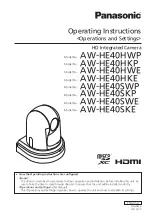
15
16
14
IInnssttaalllliinngg tthhee PPoorrtt ccoonntt..
TToo RReem
moovvee PPoorrtt
To remove the port, lift up on each Release Button and slide the
port lock away from the port.
PPoorrtt SSeeaall IInnssiiddee VViieew
w
If the port is installed before the
camera is inserted into the housing,
look from the inside of the housing
at the port seal. Check to see that the
o’ring is properly seated as shown in
figure 1 and not extruded as shown
in figure 2.
Fig. 1
Fig. 2
CCaauuttiioonn::
After installing the port, turn the Zoom Control knob on the
housing. If the Zoom Control is difficult to turn, the gear sleeve
may be warped. If necessary, reduce or omit any rubber installed
on the Zoom Clamp (Fig.F on pg.10).
If the Zoom Clamp is still
warped, use of the #5509.28 package may be required. (See page
#8)
N
NO
OTTEE:: ((lleennss ppoorrttss))
A lens port must be secured to the housing before entering the
water. Ikelite DSLR housings DO NOT come with a lens port. You
must select the correct port for each lens you will be using
underwater. For complete lens/port information and
compatibility with your Ikelite system, go to w
ww
ww
w..iikkeelliittee..ccoom
m
IInnssttaalllliinngg tthhee PPoorrtt
There are two port locks on
the front of the housing
(See housing front). Each
port lock has a Release
Button. Lift the release
button and slide each Port
Lock away from the port
opening. In the unlocked
position, the Release Button
will remain in the up
position as shown.
To prepare the port for installation, remove the port o’ring and
lightly lubricate it. The port seal is a side-to-side seal and
requires the o’ring to be lightly lubricated for easy installation.
Put a small amount of lubricant on your fingers and pull the
o’ring through your fingers to lightly lubricate it. Do not stretch
the o’ring. Check that the lip of the port where the o’ring fits
and the sealing surface on the housing are clean. Place the port,
with o’ring, into the housing port opening. Press down on the
port firmly and evenly until you feel the port slide into place.
Continue to push down on the port and push each port lock
forward until the lock fully engages. It may help to slightly
rotate the port as you push in on the port lock. Visually inspect
the port lock and confirm that the Port Lock Release Button is
seated flush against the Port Lock Body. Do not rely on an
audible "click" to indicate that the lock is engaged.
Check around the perimeter of the port seal to see that the
o’ring is properly sealed and not extruded ((PPaaggee 1144 -- FFiigg.. 22))..
13
Port Lock
Release
Button
Lift Release
Button to
Unlock
Pull Back to
Disengage
Port
Locked Position
U
Ussiinngg EExxtteerrnnaall SSttrroobbeess
This housing has Conversion Circuitry built into the housing.
When used with Ikelite DS Substrobes the Conversion Circuitry
provides real Nikon iTTL flash exposure with over and
under-exposure compensation from +1 1/3 to - 1 1/3 f-stops in 1/3
stop increments.
N
NO
OTTEESS::
-- FFllaasshh EExxppoossuurree CCoom
mppeennssaattiioonn sseett iinn tthhee ccaam
meerraa w
wiillll bbee
aaddddeedd oorr ssuubbttrraacctteedd ffrroom
m tthhee ccoom
mppeennssaattiioonn sseett oonn tthhee
hhoouussiinngg ccoonnvveerrssiioonn cciirrccuuiittrryy iinn iiTTTTLL..
-- BBaallaanncceedd FFiillll FFllaasshh ccaannnnoott bbee uusseedd..
-- D
Doo nnoott uussee rreedd--eeyyee rreedduuccttiioonn sseettttiinngg..
The Conversion Circuitry also offers Manual exposure control
with 3 1/2 f-stops of under-exposure control in 1/2 stop
increments.
The Conversion Circuitry is powered by the Ikelite DS Substrobe
when connected to the housing with the #4103.51 single or
#4103.52 dual sync cord.
See page 19 for DS Substrobe compatibility with the Conversion
Circuitry.
U
Ussiinngg IIkkeelliittee N
Noonn--D
DSS SSuubbssttrroobbeess ((SSuubbssttrroobbee 5500,, 110000AA,,
220000,, 440000)) aanndd N
NO
ON
N--IIkkeelliittee SSttrroobbeess w
wiitthh tthhiiss H
Hoouussiinngg..
The Conversion Circuitry is automatically disabled when used
with a Non-DS or Non-Ikelite Substrobe. These Substrobes can be
used in their manual mode utilizing any power settings provided
on the Substrobe.
U
Ussiinngg tthhee CCoonnvveerrssiioonn CCiirrccuuiittrryy
((SSeett D
DSS SSuubbssttrroobbee ttoo TTTTLL m
mooddee))
•• M
Mooddee aanndd CCoom
mppeennssaattiioonn D
Diiaall
Note that the TTL
compensation
values are located in
the yellow band.
Manual compensation
values are located in
the black band.
Rotate the Dial to
switch between TTL
and Manual Modes.
•• TTTTLL M
Mooddee
TTL Mode
compensation
values are indicated in
the yellow band. Place
the Setting Indicator
to TTTTLL ffoorr N
NO
O
CCoom
mppeennssaattiioonn. Rotate
the Dial either
direction to /- compensation. Place the Setting Indicator
to the desired compensation value. Note that in TTL
compensation values are in 1/3 f-stops.
•• M
Maannuuaall M
Mooddee
Manual Mode compensation values are indicated in the black
band. Rotate the Dial to place the Setting Indicator to the desired
compensation value. Note that in Manual Mode compensation
values are in 1/2 f-stops from (F) full power to -3 f-stops.
((SSeett D
DSS SSuubbssttrroobbee ttoo TTTTLL m
mooddee))
U
Ussiinngg EExxtteerrnnaall SSttrroobbeess CCoonntt..
TTL
1
-1
-1
F
-2
-3
MAN
DIAL
TTL Flash Scale (yellow = 1/3 stops)
Manual Flash Scale (black = 1/2 stops)
Setting
Indicator

























